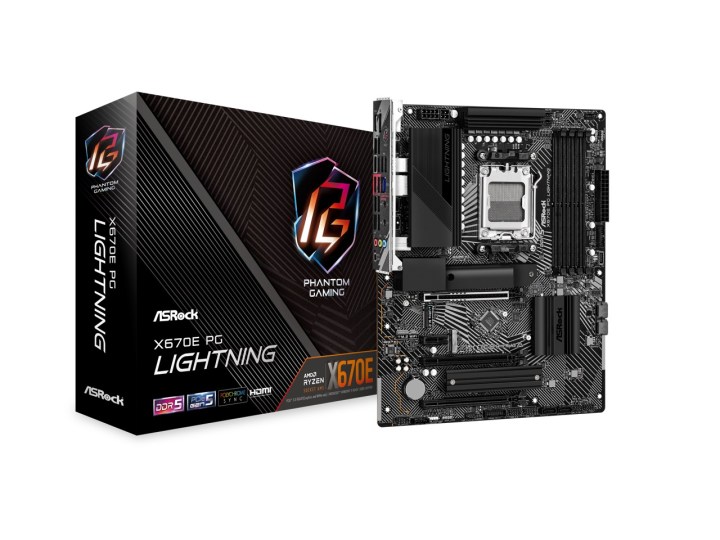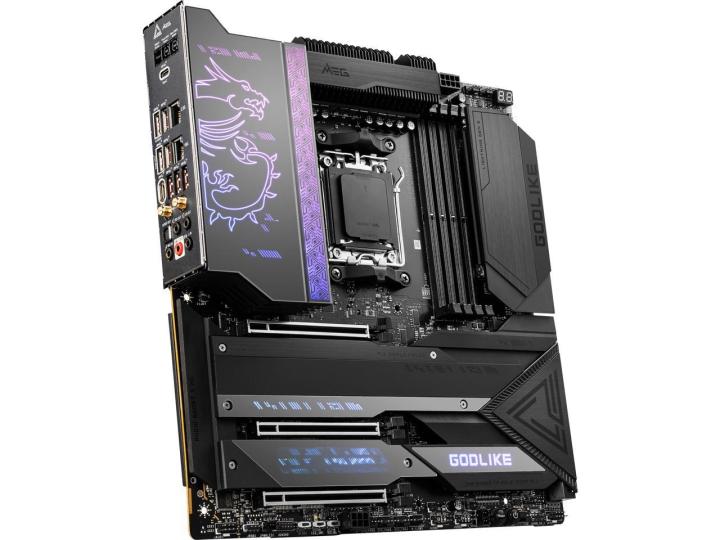The new AMD Ryzen 7000 processors are here, and for the first time in years, they require a new motherboard. AMD has finally bid farewell to the AM4 socket, which had served it well since 2016. Now, it looks to the future, introducing the AM5 socket — and with it, a slew of new motherboards for you to choose from.
Right now, only the high-end X670 and X670E motherboards are available, but in a few weeks, the cheaper B650 boards will emerge. Below, you'll find some of the best AMD Ryzen 7000 motherboards to help you make use of your top-notch CPU.
Asus ROG Crosshair X670E Extrem
The best motherboard for Ryzen 7000
This motherboard, which sits atop the Asus Ryzen 7000 motherboard lineup, has just about everything a high-end board should. You get access to Wi-Fi 6E, 10Gbps Ethernet, a mass of different connectivity options, and a beautiful micro-LED display. It's flashy, it's massive, and it's the perfect cherry on top of a gaming desktop.
The Asus ROG Crosshair X670E Extreme is an overclocker's dream, with built-in AI overclocking profiles that optimize the CPU frequency and the speed in order to hit that sweet spot, alongside the Dynamic OC Switcher. It also supports AMD EXPO for some DDR5 memory overclocking.
There's plenty of room for extra storage, with two onboard M.2 slots and two x16 slots that support PCIe Gen 5, and you can reach up to 128GB of DDR5 RAM at 6400MTps (or more with an overclock). This is a high-end motherboard made for enthusiasts, and this is reflected in the price, but it will certainly help you make the most of your new AMD CPU.

ASRock X670E PG Lightning
The best budget motherboard for Ryzen 7000
Priced in the $250 to $300 range right out of the gate, this motherboard is one of the cheaper AMD Ryzen 7000 BOARDS out there, and it's still an X670E model. While it lacks some of the features of the Asus we talked about above, it's still a good deal that doesn't cost a fortune.
ASRock touts this board's optimized VRM design. This board supports PCIe 5.0 for both the graphics card and the M.2. It sports an eight-layer PCB design that was made with stability in mind, and it's accompanied by the latest Smart Power Stage (SPS) technology for extra security and smooth power delivery.
It's not as impressive in terms of ports, but there are still ports aplenty, including USB 2.0, USB 3.2, USB Type-C, HDMI, and DisplayPort 1.4. It supports 2.5Gb/s LAN for a speedy connection, and it'll help you overclock with a wide range of features. While much less flashy than the Asus, it's a good option if you don't want to overspend.

Gigabyte X670E Aorus Xtreme
The best value motherboard for Ryzen 7000
This Gigabyte X670E Aorus Xtreme board improves upon the flaws of the ASRock we've talked about above. It offers similar networking options to the (considerably more expensive) Asus, with 10Gbps LAN and built-in Wi-Fi 6E. Data transfer is made quicker, too, all thanks to rear and front USB-C 20Gbps ports.
This motherboard looks rather good, which may be important to some users and insignificant to others. It's hard to deny that the colorful LED screen on the front adds a little bit of shine to a case, though. Gigabyte also ramps up the overclocking support with a strong 18+2+2 VRM design.
You can overclock your memory with AMD EXPO, but this also supports Intel XMP profiles. There are four M.2 slots for either the GPU or a solid-state drive (SSD), and you'll be able to update the BIOS without even installing the processor, RAM, and GPU. Unfortunately, the audio hardware on this board is based on an older Realtek audio codec, but if you're willing to overlook that, this motherboard is definitely solid.

ASRock X670E Taichi Carrara
The best-looking Ryzen 7000 motherboard
There's no accounting for taste, but this is definitely one of the best-looking AMD Ryzen 7000 motherboards we've seen so far. With its high-end look topped off with faux-marble heat spreaders, it stands out from the usual RGB-lit crowd, and it does so in style. This is both one of its perks and one of its flaws -- it won't suit every build, but if it suits your style, it'll really make your desktop stand out.
All the aesthetics aside, for a middle-of-the-pack price (as far as X670E motherboards are concerned), you're getting a lot of connectivity and power control. There are two USB 4/Thunderbolt 4 ports, eight SATA 3.0 ports, and a single PCIe 5.0 x4 M.2 slot. Unfortunately, the LAN controller is only 2.5Gbps as opposed to the 10Gbps offered by some of the other boards here.
The Taichi Carrara will do a good job of keeping temperatures and power consumption at bay with its 24+2+1 power phase and enlarged heatsink armor. You should be able to reach high overclocks on it without straining your build too much.

MSI MEG X670E Godlike
The best high-end Ryzen 7000 motherboard
You've got your fancy GPU, you've got a beefy new Ryzen 7000 CPU, and now, you're shopping for a motherboard? Well, if your wallet can handle it, this is probably as good as it gets -- but it's so very expensive that some people build a whole PC for the price of this motherboard alone.
The M-Vision Dashboard is where the fancy stuff begins. This is a fully-realized 4.5-inch IPS LCD screen, complete with touch controls, that gives you a constant overview of the state of your PC. Your CPU is overheating? No problem, the dashboard will tell you. It'll also help you check the weather, turn off your PC, and monitor all your other hardware. It connects via USB, and you can stick it onto your case for easy controls.
In terms of networking and connectivity, it's no surprise that MSI equipped this model with everything you could wish for. A total of 13 USB ports, a Wi-Fi 6E chip, onboard 10Gbps LAN support alongside a 2.5Gbps LAN controller ... If only it weren't so expensive, this motherboard would certainly be one of the best motherboards we've seen for a while now.
Frequently Asked Questions
After over five years, AMD has decided to retire the AM4 socket and introduce the AM5, complete with a new 600-series chipset.
The new socket uses a Land Grid Array (LGA) design; LGA1718, to be precise. This brings it closer to Intel's architecture than AMD's previous solution because Intel has been using LGA sockets for several generations now, while AMD has stayed true to Pin Grid Array (PGA) up until now. As the name itself suggests, LGA1718 comes with 1,718 pins, a large upgrade over the AM4, which only had 1,331.
Switching to AM5 paves the way for the new motherboards. The 600-series chipset for AMD Ryzen 7000 includes high-end X670E and X670 motherboards, followed by the more budget-friendly B650. However, the mid-to-entry-level boards will not launch until a little later.
Bad news if you were hoping to pair your new Zen 4 CPU with a stick or two of DDR4 RAM — AMD has made the switch to DDR5, and DDR5 only. This means that you can no longer use DDR4 memory combined with a Ryzen 7000 processor and will need to opt for some of the best RAM currently available.
That's a bold move from AMD, and it distinguishes it from Intel, which still continues to support DDR4 and DDR5 memory simultaneously on its new Intel Raptor Lake platform.
With the upgrade to DDR5 RAM, AMD also now offers access to PCIe 5.0 connectivity, which was unavailable on the AM4 socket.
Both the X670 and the X670E motherboards are the high-end options for the new AMD Ryzen 7000 processors. However, the X670E, also known as Extreme, is even more premium and enthusiast-grade than the X670, and it may often come packing some extra features. The exact differences will vary between manufacturers.
There is one key difference that remains true for all X670E motherboards, though. Both the X670 and the X670E motherboards offer PCIe 5.0 connectivity, but the Extreme option grants you access to the new PCIe standard for both the M.2 slot and the PCIe slot. It's a different story for the X670, which will only feature one of the two.










0 Comments